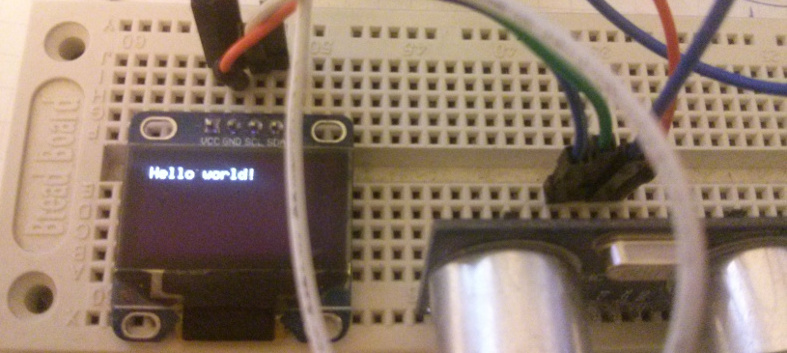Not so far ago @pfalcon mentioned in microasync bugtracker about a port of asyncio for micropython – uasyncio. After that I ported asynchronous queue from asyncio to uasyncio, so now it can replace microasync.
So I conceived a little project: device which prints information from pyboard gyro sensor and ultrasonic sensor to OLED display. Sounds very simple, but it need to update information on display when data from one of sensors changed. So interaction with sensors should be non-blocking.
I found almost well done lib (fork which supports drawing text) for interacting with my OLED display and lib for working with ultrasonic sensor (non-blocking version).
First of all I created decorator for simplifying creating generators which returns a queue and make all interaction through it:
class OnlyChanged(Queue):
def __init__(self, *args, **kwargs):
self._last_val = None
super().__init__(*args, **kwargs)
def put(self, val):
# Put in queue only if value changed
if val != self._last_val:
yield from super().put(val)
self._last_val = val
def chan(fn):
def wrapper(*args, **kwargs):
q = OnlyChanged(1)
get_event_loop().call_soon(fn(q, *args, **kwargs))
return q
return wrapper
So now it’s simple to write generator, which prints to display data received from the queue:
@chan
def get_display(q, *args, **kwargs):
display = Display(*args, **kwargs)
while True:
lines = yield from q.get()
display.write(lines)
>>> display = get_display(pinout={'sda': 'Y10',
... 'scl': 'Y9'},
... height=64,
... external_vcc=False)
>>> yield from display.put('Hello world!')

And generator for the ultrasonic sensor which puts values to the queue:
@chan
def get_ultrasonic(q, *args, **kwargs):
ultrasonic = Ultrasonic(*args, **kwargs)
while True:
val = yield from ultrasonic.distance_in_cm()
yield from q.put(val)
>>> ultrasonic = get_ultrasonic('X1', 'X2')
>>> yield from ultrasonic.get()
28.012
Similar generator for the pyboard gyro sensor:
@chan
def get_gyro(q):
accel = pyb.Accel()
while True:
val = accel.filtered_xyz()
yield from q.put(val)
>>> gyro = get_gyro()
>>> yield from gyro.get()
(12, 9, 72)
And by combining all of them it’s very similar to write program for expected device:
def main():
display = get_display(pinout={'sda': 'Y10',
'scl': 'Y9'},
height=64,
external_vcc=False)
current = {'dist': 0, 'xyz': (0, 0, 0)}
shared_q = alts(dist=get_ultrasonic('X1', 'X2'),
xyz=get_gyro())
while True:
source, val = yield from shared_q.get()
current[source] = val
yield from display.put(
'Distance: {:0.2f}cm\n'
'x: {} y: {} z: {}'.format(current['dist'], *current['xyz']))
>>> loop = get_event_loop()
>>> loop.call_soon(main())
>>> loop.run_forever()
So the result code is very simple, all components are decoupled and it’s easy to test. Video of result: